| Lutjanus decussatus (Cuvier 1828), the
Checkered Snapper. Western Pacific and Eastern Indian Ocean from
New Guinea to Southern India. This one off of Gili Air, Lombok,
Indonesia. To one foot in length. |
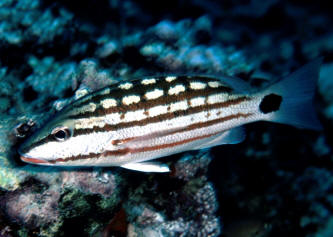
|
Bigger PIX:
The images in this table are linked
to large (desktop size) copies. Click on "framed" images
to go to the larger size. |
|
%20MD.JPG)
|
| Lutjanus fulviflamma (Forsskal 1775), the
Black-Spot Snapper. East Africa, the Red Sea to Samoa. To fourteen
inches in length. This one off of Queensland, Australia. Note the
yellow lateral stripes that the similar L. russelli
lacks. |
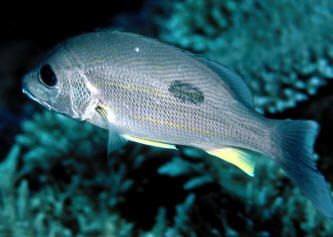
|
| Lutjanus fulvus (Forster 1801),
the Blacktail Snapper. Indo-Pacific; East Africa to Marquesas, Line
Islands, Japan, Australia. Occasionally used as an aquarium fish.
Young found in sheltered bays, around mangroves. Adults on
surrounding reefs near boulders. Feed at night on fishes,
crustaceans, sea cucumbers, squid and octopus. Pix from Hawai'i
(aquarium at Waikiki), Bunaken, Indonesia and Nuku Hiva, Marquesas,
Polynesia.
http://www.fishbase.org/Summary/
SpeciesSummary.cfm?ID=262&genusname=Lutjanus&speciesname=fulvus |
 |
 |
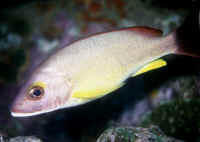 |
Bigger PIX:
The images in this table are linked
to large (desktop size) copies. Click on "framed" images
to go to the larger size. |
|
%20MD.JPG)
|
| Lutjanus gibbus (Forsskal 1775), the Humpback Red
Snapper. Indo-Pacfic; East Africa, Red Sea to Society Islands. To about 18".
French Polynesia 2018 |
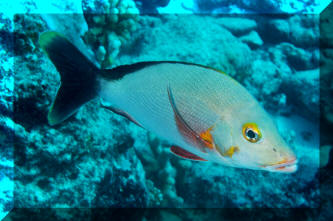
|
| Lutjanus griseus (Linnaeus 1758), the Gray
Snapper. Tropical West Atlantic. Freshwater, brackish, marine. 89
cm., 20 kg. maximum. Occasionally imported as juveniles for the
aquarium interest. Nocturnal feeder on fishes, crustaceans,
worms. |
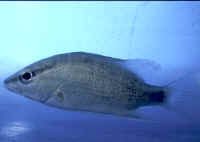
|
| Lutjanus guttatus (Steindachner 1869), the
Spotted Rose Snapper. Sea of Cortez to Peru. To 40 cm. Costa Rica (Pacific side) 2011 |
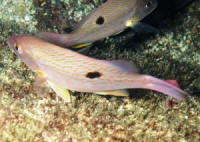
|
| Lutjanus inermis (Peters 1869), the Golden
Snapper. Mexico to Panama on the Pacific coast. To 35 cm.
"Normal" adults in Costa Rica (Pacific
side) 2011 |
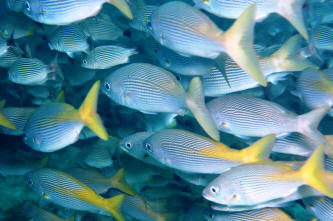
|
| Lutjanus jocu (Bloch &
Schneider 1801), the Dog Snapper. Prominent white triangle below eye. Western Atlantic; Massachusetts
to Brazil, including the Gulf of Mexico, and the Eastern Atlantic;
St. Paul's Rocks and Ascension Island. To Thirty two inches
maximum length. A specimen off of Roatan, Honduras. |
.JPG)
|
Bigger PIX:
The images in this table are linked
to large (desktop size) copies. Click on "framed" images
to go to the larger size. |
.JPG) %20MD.JPG)
%20MD.JPG) |
Of the handful of species so marked, the Blue-and-Gold-Striped
Snappers (Lutjanus kasmira and Lutjanus quinquelineatus from the
Indo-Pacific, and Lutjanus viridis
of Mexico's western coast) occasionally found in the trade are exemptions to the
"one-to-a-tank" snapper rule. These smaller Lutjanids (about a foot), are best
kept in a small school, of 3-5 individuals.
|
Lutjanus kasmira (Forsskal 1775), the Common
Bluestripe Snapper. Indo-Pacific; Red Sea, eastern Africa to the
Marquesas, south to Australia, over to the Southeast Atlantic; South
Africa. Here in the Maldives and Australia. Note the lower third of the
body is white and the presence of only four blue stripes...
distinguishing marks from the Five-Lined Snapper below.
|
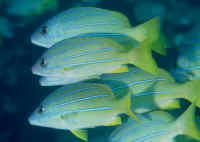
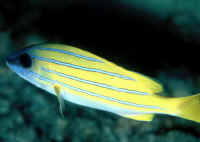
|
|
Verticals (Full/Cover Page
Sizes Available) |
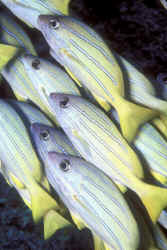 |
| Lutjanus mahogani (Cuvier 1822), the
Mahogany Snapper. Tropical West Atlantic; N. Carolina to Venezuela. To 19
inches in length (most much smaller). Bonaire. |
%20MD.JPG)
|
Bigger PIX:
The images in this table are linked to large (desktop size) copies. Click on
"framed" images to go to the larger size. |
|
%20MD.jpg)
%20MD.jpg)
|
| Lutjanus quinquelineatus
(Bloch 1790), the Five-Lined Seaperch. Persian Gulf to Fiji. To fifteen
inches in length (most much smaller). This eight inch individual off of
Heron Island, GBR, Australia. |

|
Bigger PIX:
The images in this table are linked to large (desktop size) copies. Click on
"framed" images to go to the larger size. |
|
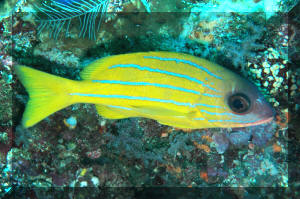
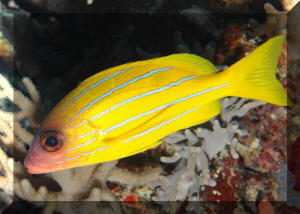
|
To: part 1,
part III
|
|

